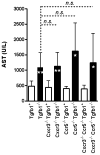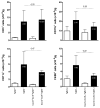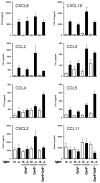Liver inflammation in a mouse model of Th1 hepatitis despite the absence of invariant NKT cells or the Th1 chemokine receptors CXCR3 and CCR5
- PMID: 22906987
- PMCID: PMC3460069
- DOI: 10.1038/labinvest.2012.104
Liver inflammation in a mouse model of Th1 hepatitis despite the absence of invariant NKT cells or the Th1 chemokine receptors CXCR3 and CCR5
Abstract
The specific mechanisms that mediate CD4(+) T-cell-mediated liver injury have not been fully elucidated. CD4(+) invariant natural killer T (iNKT) cells are required for liver damage in some mouse models of hepatitis, while the chemokine receptors CXCR3 and CCR5 are considered dominant Th1 chemokine receptors involved in Th1 trafficking in inflammatory conditions. BALB/c-Tgfb1(-/-) mice spontaneously develop Th1 hepatitis. Here, we directly test the hypotheses that iNKT cells or the Th1-cell chemokine receptors CXCR3 and CCR5 are required for development of liver disease in Tgfb1(-/-) mice. Tgfb1(-/-) mouse livers exhibited significant increases in iNKT cells and in ligands for CXCR3 or CCR5. Tgfb1(-/-) mice were rendered deficient in iNKT cells, CXCR3, CCR5, or both CXCR3 and CCR5, by cross-breeding with appropriate knockout mice. Tgfb1(-/-) mice developed severe liver injury, even in the absence of functional CD1d/iNKT cells, CXCR3, CCR5, or both CXCR3 and CCR5. Liver CD4(+) T cells accumulated to high numbers, and spleen CD4(+) T-cell numbers declined, regardless of the functionality of the CXCR3/CCR5 response pathways. Similarly, dendritic cells and macrophages accumulated in Tgfb1(-/-) livers even when CXCR3 and CCR5 were knocked out. Th1-associated cytokines (IFN-γ, TNF-α, IL-2) and chemokines (CXCL9, CXCL10) were strongly overexpressed in Tgfb1(-/-) mice despite knockouts in CD1d, CXCR3, or CCR5. These studies indicate that the cellular and biochemical basis for CD4(+) T-cell-mediated injury in liver can be complex, with myriad pathways potentially involved.
Figures










Similar articles
-
Progression of autoimmune hepatitis is mediated by IL-18-producing dendritic cells and hepatic CXCL9 expression in mice.Hepatology. 2014 Jul;60(1):224-36. doi: 10.1002/hep.27087. Epub 2014 May 28. Hepatology. 2014. PMID: 24700550
-
The chemokine receptor CXCR3 limits injury after acute toxic liver damage.Lab Invest. 2012 May;92(5):724-34. doi: 10.1038/labinvest.2012.48. Epub 2012 Mar 19. Lab Invest. 2012. PMID: 22430509
-
Interleukin-27 and IFNγ regulate the expression of CXCL9, CXCL10, and CXCL11 in hepatitis.J Mol Med (Berl). 2015 Dec;93(12):1355-67. doi: 10.1007/s00109-015-1319-6. Epub 2015 Jul 23. J Mol Med (Berl). 2015. PMID: 26199110
-
The role of chemokines as inflammatory mediators in chronic hepatitis C virus infection.J Viral Hepat. 2007 Oct;14(10):675-87. doi: 10.1111/j.1365-2893.2006.00838.x. J Viral Hepat. 2007. PMID: 17875002 Review.
-
Targeting of Th1-associated chemokine receptors CXCR3 and CCR5 as therapeutic strategy for inflammatory diseases.Mini Rev Med Chem. 2007 Nov;7(11):1089-96. doi: 10.2174/138955707782331768. Mini Rev Med Chem. 2007. PMID: 18045212 Review.
Cited by
-
Identification of Targets for Subsequent Treatment of Crohn's Disease Patients After Failure of Anti-TNF Therapy.J Inflamm Res. 2023 Oct 17;16:4617-4631. doi: 10.2147/JIR.S422881. eCollection 2023. J Inflamm Res. 2023. PMID: 37868830 Free PMC article.
-
Regulatory T Cell Plasticity and Stability and Autoimmune Diseases.Clin Rev Allergy Immunol. 2020 Feb;58(1):52-70. doi: 10.1007/s12016-018-8721-0. Clin Rev Allergy Immunol. 2020. PMID: 30449014 Review.
References
Publication types
MeSH terms
Substances
Grants and funding
LinkOut - more resources
Full Text Sources
Medical
Molecular Biology Databases
Research Materials
Miscellaneous

